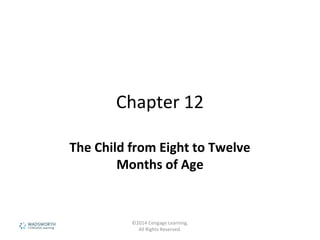Weitere ähnliche Inhalte
Ähnlich wie Swim ppt ch12 (20)
Kürzlich hochgeladen (20)
Swim ppt ch12
- 1. Chapter 12
The Child from Eight to Twelve
Months of Age
©2014 Cengage Learning.
All Rights Reserved.
- 2. Materials and Activities
• Materials for this age group must be
challenging and safe:
– Most infants in this age range are mobile and will
encounter an expanded world
– Small enough to grasp with the palm and fingers
or with thumbs and forefingers, but not small
enough for them to swallow
• Materials may be homemade or commercially
made
©2014 Cengage Learning.
All Rights Reserved.
- 3. Physical Development
• Infants of this age are rapidly developing gross motor
skills:
– The sequence of locomotion proceeds from
creeping to crawling, pulling up to standing,
stepping to walking
• Infants of this age use the following fine motor
skills:
—Poking, pushing, pulling, using pincer grasp,
clapping, bringing hands to mid-point, banging
objects, making marks with crayon, transferring
toys hand to hand
• Infants use fingers and spoon to eat
• Nap schedules are changing
©2014 Cengage Learning.
All Rights Reserved.
- 4. Suggestions for Implementing Curriculum--
Physical Development
• Provide adequate floor space where they can roll,
crawl, climb, reach, stand, and walk
• Remove furniture that could tip over, cover sharp
corners
• Place toys slightly beyond reach to stimulate
movement
• Allow infant to stand and step around to hold on to
furniture
• Provide materials for grasping, mouthing, banging,
throwing, dropping, carrying
• Allow infant to hold bottle, cup, spoon, finger food
©2014 Cengage Learning.
All Rights Reserved.
- 5. Cognitive and Language Development
• Cognitive Development
– The processes of assimilation and accommodation
help children to make sense of information
• Piaget’s Sensorimotor Stage of Cognitive
Development:
– In Stage 3, the infant continues to explore object
permanence
– Infants imitate people and things not present,
deferred imitation
©2014 Cengage Learning.
All Rights Reserved.
- 6. Suggestions for Implementing
Curriculum--Cognitive Development
• Play hiding games with familiar objects
• Introduce games where actions are imitated
and repeated
• Follow the child’s lead
• Verbalize the child’s actions
©2014 Cengage Learning.
All Rights Reserved.
- 7. Cognitive and Language Development
• Language Development
– About one year of age, infants typically speak their
first recognizable words and use a combination of
sounds, babbling, and single words to communicate
with themselves and others
– Responsiveness to babbling builds vocabulary
– Book reading guides young children in turn-taking
patterns and conversation
– Young children can express their ideas using writing
tools
©2014 Cengage Learning.
All Rights Reserved.
- 8. Suggestions for Implementing Curriculum--
Language Development
• Name important objects with one word
• Reinforce talk about Mama and Dada
• Use infant’s name when you talk with him
• Label actions such as “bye-bye”
• Read aloud to infants, point to pictures as you
read
• Allow infants to begin to scribble
©2014 Cengage Learning.
All Rights Reserved.
- 9. Emotional Development
• Infants express feelings such as happiness and anger
• Infants can now conceive of goals or desires and
actively pursue them
• Teachers must help infants and family members to
develop rituals to deal with emotions
• At this age, infants are developing preferences and
independence
• Redirecting negative behaviors to positive works
better than drawing attention to negative
• The temperaments of infants produce varying
responses and intensity of response
©2014 Cengage Learning.
All Rights Reserved.
- 10. Suggestions for Implementing Curriculum--
Emotional Development
• Use calm, quiet talking to describe feelings
• Allow infants to make choices
• Identify and record preferences, use this
information for planning
• Encourage attempts at self dressing and
feeding
• Provide attention for appropriate behavior
• Use ‘no’ sparingly
©2014 Cengage Learning.
All Rights Reserved.
- 11. Social Development
• The mobility infants now have enables them
to encounter different people or to move
away from them
• Infants at this age do not clearly separate
others’ desires and needs from their own
• Securely attached mobile infants will stay with
a trusted caregiver, watching newcomers with
a healthy suspicion
©2014 Cengage Learning.
All Rights Reserved.
- 12. Suggestions for Implementing Curriculum--
Social Development
• Low teacher-child ratios and a primary caregiving
system assist in meeting the social needs of
infants
• Verbalize limits and help infant choose other
activities and materials
• Play responsive games like ‘patty-cake’
• Provide enough toys and materials so infant does
not need to share
• Provide positive verbal attention even though
you may be busy with another child
©2014 Cengage Learning.
All Rights Reserved.
- 13. Spotlight on Research
• Infants and Divorce
– Given the importance of healthy attachment, the
impact of divorce on very young children should
not be overlooked
– Infants are especially vulnerable to emotional and
physical effects of divorce
– Research has substantiated the positive impact of
both mothers and fathers on developmental
outcomes
©2014 Cengage Learning.
All Rights Reserved.
- 14. Checkpoint Discussion Questions
• List five strategies you can use to facilitate the
physical development of an infant in this age
range.
• An 11-month-old is responding to labels of
objects. Describe a game you can play with
this child to stimulate the child’s
understanding and use of language.
©2014 Cengage Learning.
All Rights Reserved.
- 15. Checkpoint Discussion Questions
• Why is sharing difficult for the infant between
8 and 12 months of age?
• Identify four ways an infant in this age range
asserts independence.
• Explain the concept of object permanence and
how it reflects and impacts both social and
cognitive development.
©2014 Cengage Learning.
All Rights Reserved.
